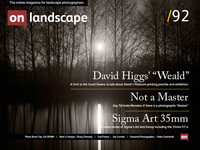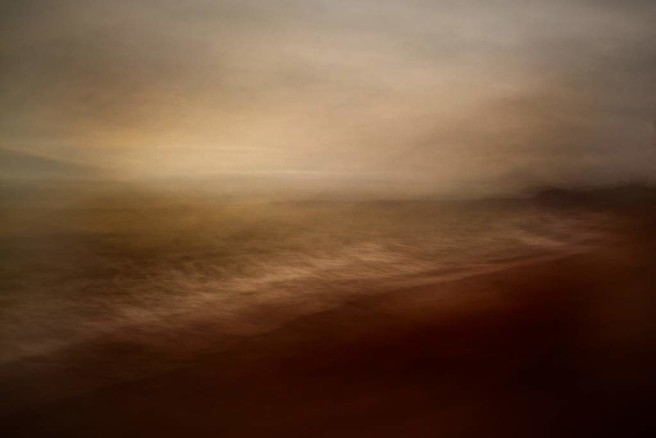A Wash of Colour

Thomas Peck
The real pleasure of photography is that it forces me to slow down and really look. That’s never easy in our rushed world, so a chance to stop, look and see is truly valuable.
Much photography is descriptive in a literal sense. Sharp lenses, high resolution cameras transcribe in great detail and clarity whatever subject the photographer choses.
The viewer recognises instantly what is being shown; as a result interpretation is relatively simple. That is not the case with Doug Chinnery’s wonderful moody seascape view above. (Click here for other articles Doug Chinnery has written for On Landscape.)
Here we have the opposite of the ‘straight shot’. The norms of photography have been subverted. There is no sharpness, no precisely described subject. All is blur and movement.
The viewer must react on an emotional level rather than through recognition. We are presented with a personal vision of a land/seascape which conveys a dark, dramatic and slightly foreboding mood. It is almost impossible to look at this photograph and not wonder if it is, in fact, a photograph!
What can we actually see? The wave breaking on the beach is blurred. The distant horizon is indistinct. We can make out what seem to be thin strips of dark land in the distance on the right.
These are echoed, possibly, with a thin triangular shape that juts in from the left side of the picture, although this could easily be cloud. The foreground beach is dark and featureless. It is not really clear whether this is in fact a beach.
The sky is sombre. There seems to be a high level of cloud in a greyish tone, and a lower, browner level that reflects the colour of the sky and the beach.
The palette of browns, grey, greens and faint yellows are all muted. The light in the distance does not herald a bright dawn or a glorious sunset. The day that is just beginning, or ending, is most likely going to be cold and wet. Functionally the distant light does play an important role. It adds depth to the picture and locks down the viewer’s impression that this is indeed a land/seascape vista. Without the distant light, the picture would become truly abstract.
To achieve this the photographer has deliberately used his camera in a non-conventional way. The impressionistic blur and lack of sharpness is created through a combination of camera movement during the exposure, coupled with a long shutter speed. The tripod, that key support for the landscape photographer, has been ignored here. By breaking with convention Chinnery has created this moody image to show what he feels rather than what he sees. The style impressionistic. The obvious link from a British context is to think of Turner who used hugely flowing sweeps of paint and colour to convey the elemental forces of nature.
But I wonder if Doug Chinnery’s image can go one step further. It reminds me of German Expressionism, where colour, form and texture show an inner emotional reality. The dramatic seascapes of Emil Nolde come to mind, particularly those from the series of ‘Unpainted Pictures’. Banned from painting by the Nazis he went into inner emigration by retiring to the cold flat northern coastline on the border with Denmark. There he painted in secret. He used watercolours – so that if he got a visit from the local Nazi bigwig they wouldn’t smell his oil paints.
Like Chinnery, Nolde subverted the usual painting process. He would lay down washes of colour, which would suggest images and moods to him. He would then use a few more definitive lines to suggest the outline of an image. This is what Chinnery has done. All is colour and movement. Form is secondary. Chinnery’s resultant creation is an image that is quite bleak, and immensely beautiful.


